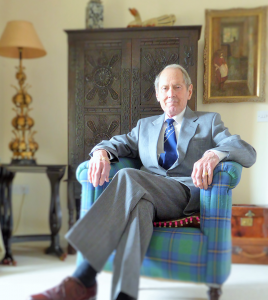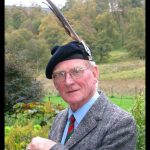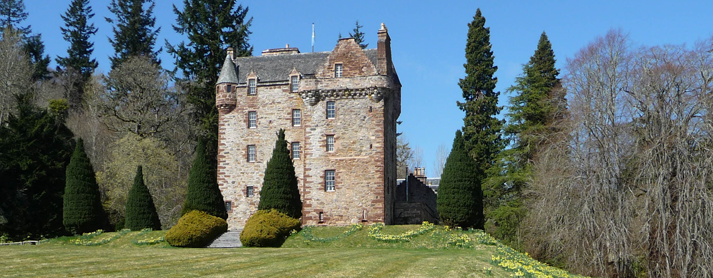By John King Bellassai*
We’ve just wrapped up another annual celebration
of Tartan Day–observed each year on 6th April, the anniversary of
the 1320 Declaration of Arbroath.
Parties and parades behind us for yet another year, it is only natural
that we reflect on the significance of it all for those of us in the Ancestral
Diaspora. This is especially timely, given that next year we will celebrate the
20th anniversary of the Tartan Day holiday, which has now firmly
taken root in communities all across our land.
(As I’ve pointed out before, the real meaning of Tartan Day is contained
in the plain wording of the standing resolutions of both houses of the U.S.
Congress that authorize its observance: To
recognize and celebrate the many contributions of Scots, and
Scottish-Americans, to the founding and subsequent development of the United
States.)
Many of our Scottish cousins love to come over and help us celebrate Tartan Day, this year including the First Minister. But they still tend to wince at the name (which we actually borrowed from the Canadians), as being romantically Victorian, maybe even a bit brigadoonish. That is short-sighted on their part. Even more than the thistle or the saltire, the tartan is a universally recognized symbol of the Scottish ‘brand’—not just something highland, but something quintessentially Scottish. After all, it is well-documented that lowland ladies widely wore tartan shawls and wraps to protest the Union in the earliest days of the 18th century—a sentiment that many in modern Scotland seem to be embracing once more. And a piece of simple tartan has even been found stuffed inside a clay pot, buried at the base of Hadrian’s Wall, wrapped around a fistful of 1st century Roman coins. So tartan has been a commonly recognized symbol of “things Scottish” for a long, long time. And here in America, 32 of our 50 states—typically states with heavy Scottish immigration in their respective histories–now have officially adopted their own tartans, registering them with the Scottish Tartans Authority.
The romance of the name “Tartan Day” aside, many,
maybe most, in Scotland and even some here in America still pooh-pooh the
claimed inspiration for our Tartan Day holiday being found in the Declaration
of Arbroath. But should they so quickly dismiss the link? I think not.
Much recent scholarship supports it, and an actual analysis of the
structure of the two documents, even some striking similarities in phrasing,
suggest that 1320 was indeed a powerful inspiration for 1776. Not the only one, to be sure, but an
important one, nonetheless.
The key to understanding the link between the two
“declarations” lies in the fact that the American Revolution came right on the
heels of the Scottish Enlightenment and that the works of many Scottish
philosophers and academicians were being widely read, and deeply appreciated,
in the American colonies in the decades immediately preceding our break with
Britain. Though all estimates tell us
that Scots immigrants to the American colonies prior to 1776 made up less than
10 percent of the general population, their influence on the worldview held by
the educated segment of the population was far out of proportion to their
numbers. Why so?
The answer lies in the fact that 18th
century Scots immigrants included many well-educated clergymen and graduates of
Scottish universities—Edinburgh, Glasgow, and Aberdeen—the seats of the Enlightenment. These two classes of immigrants, clergymen
and university graduates, were well-acquainted with the works of Adam Ferguson,
Francis Hutcheson, David Hume, Lord Kames and others that espoused the
so-called “Common Sense Philosophy” then prevalent among the educated classes in
Scotland. Both at the grammar school
level and in the majority of the six universities in the American colonies
(four of which were founded by Scots), Scottish immigrants predominated in the
teaching ranks; as a result, these Scottish Enlightenment works were widely
read and debated among both faculty and students in America.
We know that far from being an obscure document,
the Declaration of Arbroath was well known
in Scotland in the years immediately preceding the adoption of the
Treaty of Union in 1707, because it featured in the so-called “pamphlet wars”
that swirled around that event.
Moreover, we know the Declaration of Arbroath itself went through at
least four mass printings in Scotland in the decades between 1707 and 1776—showing
that it was widely read and its sentiments appreciated. But
did this knowledge really cross the Atlantic?
In many ways, the key to understanding how the Scottish
Declaration of Arbroath came to influence the American Declaration of
Independence is to understand the relationship between William Small and Thomas
Jefferson. Small was born in Scotland in
1734 and emigrated to America in 1758, settling in Virginia, where he became a
professor of rhetoric at the College of William & Mary in Williamsburgh. But prior to emigrating, Small had attended
Marischal College in Aberdeen, graduating in 1755. And while a student there, he studied under
William Duncan, Professor of Natural Philosophy, whose 1748 work, Elements of Logick–the dominant logic
treatise of its time–waswidely read,
both in Scotland and in America. Jefferson
studied under Small at William & Mary, graduating in 1761; through Small he
became well acquainted with the work of Duncan. The two men, Jefferson and
Small, remained life-long friends. In
his autobiography, Jefferson described Small as his mentor.
In March of 1764, shortly after graduating from
William & Mary, Jefferson purchased a copy of William Robertson’s The History of Scotland, which addressed
in great detail the events of the Scottish wars of independence, culminating in
the Declaration of Arbroath. We also know
that Jefferson’s mother’s family, the Randolphs, who numbered among the
Virginia gentry, claimed descent from Thomas FitzRandolph, Early of Moray,
nephew of King Robert the Bruce and himself a signer of the Declaration of
Arbroath. And we know that Jefferson was
aware of this claimed descent on his mother’s side. Doubtless this purported connection
with a signer of the Declaration of Arbroath affected Jefferson’s appreciation
of the events of 1320. A review of the
catalog of his library at Monticello shows that Jefferson later owned works by
almost all the great thinkers and writers of the Scottish Enlightenment,
including Hutcheson, Hume, Ferguson, Kames, Adam Smith, and others—a life-long
interest he kept.
The structural organization of the American
Declaration of Independence is a logical syllogism and this suggests Jefferson
was inspired by the logician and rhetorician Duncan, whose work was taught to
Jefferson by Small. Jefferson’s document
conforms to the structure recommended by Duncan for conveying the maximum
degree of conviction and certainty—a series of five propositions–(1) that all
men are created equal; (2) that they are endowed by their Creator with certain
unalienable rights; (3) that among these are life, liberty and the pursuit of
happiness; (4) that to secure these rights, governments are instituted among
men; and (5) that when any form of government becomes destructive of these
ends, it is the right of the people to alter or abolish it. This is followed in the Declaration of
Independence by a so-called “self-evident” major premise: That when government
becomes tyranny, men have a right to rebel against it. This entire structure conforms carefully with
Duncan’s rhetorical standards for proving any proposition, as contained in his
1748 treatise.
These facts aside, did the 1320 Declaration directly
influence the 1776 Declaration? Apart
from both declarations being of similar length and signed by approximately the
same number of “worthies” (39 bishops and nobles at Arbroath, 56 delegates at
Philadelphia, appointed by the 13 colonies), many of the clauses in Jefferson’s
declaration closely echo sentiments in the Declaration of Arbroath, even down
to a similarity in many of the words used:
For example, both summon God to be their witness as to the rightness of
their cause (the Scots calling him “the Supreme King and Judge”, the Americans
calling him “the Supreme Judge of the World”).
Each contains a list of grievances against the tyrannical actions of a
far-away English king as justification for them to take up arms. Each declares that the assent of the governed
is a key ingredient in the new political order it is advocating—for the
Scottish people in 1320, to throw off the English yoke and choose their own
king (The Bruce), from among their own citizens; for the Americans in 1776, to
throw off the English yoke and set up a new form of self-government (a
constitutional republic) by which to govern themselves. And each says that if the new government
does not meet the peoples’ expectations, they may change it, yet again. Each says the freedoms for which they fight
are meant to apply to all their citizens (the Scots listing “Jew and gentile
alike”). In each instance, the signers
pledge to support and defend each other. And in each instance, the signers say
they enter into this written compact for freedom alone, to which cause they
pledge their lives and their sacred honor.
Once drafted, Jefferson submitted his Declaration to the
assembled members of the Continental Congress, which referred it to committee,
where it was amended and finalized. Two
other prominent Scottish immigrants were among the members of that Continental
Congress—John Witherspoon and James Wilson—and each argued forcefully for its
passage in the debates which followed. The Rev. John Witherspoon emigrated from East Lothian to New
Jersey in 1768; James Wilson emigrated from Fife to Pennsylvania in 1765. Both men were extremely well educated
Scots and certainly knew of the Declaration of Arbroath, not only the wording
itself but the history of its adoption.
The first of the two, Witherspoon, was a Presbyterian
minister—the only clergyman among the delegates—who had become President of the
College of New Jersey (later renamed as Princeton University). The second, Wilson, was an accomplished lawyer
who went on to become an Associate Justice of the U.S. Supreme Court. Drawing on their strong educational
backgrounds as graduates of Scotland’s leading universities, both men contributed
strong support to Jefferson’s Declaration.
Witherspoon, sixth
President of the College of New Jersey (now Princeton), was educated at the
Universities of St. Andrews and Edinburgh. He was ordained a minister in the
Church of Scotland in 1745 and only emigrated to America after actively being
urged to do so by Benjamin Rush, who visited Paisley expressly to recruit him behalf
of the college. During his 25 years in
the job, Witherspoon transformed the small Presbyterian college, founded
primarily to train clergymen, into the preeminent university in America. A delegate from New Jersey to the Continental
Congress and the only clergyman among them, Witherspoon actively served on over
100 committees and was the most outspoken among the delegates on behalf of full
political separation from Britain. Throughout
his academic career, Witherspoon was an eloquent and outspoken proponent of the
“Common Sense” Philosophy espoused by the Scottish Enlightenment scholars
Hutcheson, Hume, Reid, Kames, and others, which he taught at Princeton.
Witherspoon not
only himself signed the Declaration of Independence, but in the decade preceding
it, educated many of the first generation of political leaders in the new
United States of America. From among his students came 12 other members
of the Continental Congress, each of whom signed the Declaration of
Independence, plus one American President (James Madison), one American Vice
President (Aaron Burr), 37 federal judges (three of whom later became U.S.
Supreme Court justices), 28 later U.S. senators, and 49 later U.S.
congressmen. President John Adams once
said of Witherspoon, “I know of no character, alive or dead, who has done more
real good for America.”
Wilson, known in America as “James of Caledonia”, was also a delegate to the first Continental Congress, but from Pennsylvania. He had attended the universities of Glasgow, St. Andrews and Edinburgh before emigrating and thus was equally well read in the works of the Scottish Enlightenment as were William Small and John Witherspoon. Imbued with the ideas of the Scottish Enlightenment, he moved to Philadelphia in 1766, to begin teaching at the College of Philadelphia (now the University of Pennsylvania), which awarded him an honorary Master of Arts degree. Wilson began to read the law at the office of John Dickinson a short time later; after two years of study he joined the bar in Philadelphia, setting up his own practice in nearby Reading, Pennsylvania in 1767. Wilson was very highly regarded by George Washington, who in his memoirs praised Wilson’s abilities and temperament. A leading legal theorist in colonial America, he was one of the six original justices appointed by President Washington to the U.S. Supreme Court shortly after the Constitution was adopted in 1789.
One of only six
men to sign both the Declaration of Independence in 1776 and the Constitution
in 1789, Wilson contributed greatly to the constitutional debates of the 1780’s
which led to the formulation of the modern American tri-partite political
system, consisting of co-equal executive, legislative and judicial branches, as
embodied in the U.S. Constitution. And
it was Wilson who convinced Congress to directly state that all powers of
government, any government, are ultimately derived from the people—a characteristically
Scottish notion and one which had been clearly articulated by the Scots in the
Declaration of Arbroath in 1320.
* * * * * * * * * * * * * *
[This article appears in abbreviated form in the current issue of Scots Heritage Magazine. It is reprinted here in its entirety with the permission of the editors of that publication.]
* John King Bellassai is President
of the Council of Scottish Clans & Associations (COSCA) and Vice President
of the National Capital Tartan Day Committee.
(His maternal grandfather, John King, after whom he is named, emigrated
from Killearn, in Stirlingshire, to America in 1910.)






